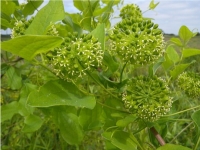Description
The carrion-flower is a non-woody climbing vine that can grow up to eight feet long. The leaves are alternate and typically 3.5" long and 2.5" wide. They can either be ovate-oval to broadly ovate-lanceolate in shape. At the base of each leaf petiole, there is usually a pair of tendrils that help the vine cling to plants or other objects for support. You can find carrion-flower blooming May to June with small (1/4" across) greenish-white flowers. carrion-flower is dioecious, meaning each vine is either male or female; so for the carrion-flower to produce seed, a male and female plant needs to be near one another.
The common name "carrion" comes from the scent of the flowers, which smell like decaying flesh. This sometimes not-so-pleasant scent attracts various types of flies, bees and other insects to pollinate the flowers.
Range/Habitat
The carrion-flower can be few and far-between in Wisconsin, but if you look for this plant, you are likely to find it in full sun or partial shade habitats with moist soil. These habitats include: savannas, woodland openings and woodland boarders.
Wildlife Value
The flowers of carrion-flower are primarily pollinated by a variety of small bees, flies, and beetles. While the flies and beetles suck nectar or feed on the pollen, the bees will suck nectar or collect pollen. The berries (similar to the size and look of blueberries) of Smilax spp. are typically eaten by game birds and songbirds. Ruffed grouse and wild turkey will also eat newly sprouted leaves and the buds of the vines. The berries are also a food source for some mammals including black bear, opossum, raccoon, and other species.

Ethnobotanical value
In earlier times, carrion-flower had many edible and medicinal purposes. Consumed either by using the leaves in tea or eating small amounts of the root, it was believed to help indigestion, muscle pain, and respiration issues
Landscaping Ideas
This growing season, if you are going to landscape your yard, consider using plants that are native to your area! Carrion-flower, along with other vines, is a great addition to any yard where the conditions are right. It can soften the side of your house or fence, without growing out of control. Natives are also lower maintenance; they don't need to be watered as much as non-natives, once they become established. You will also find a wide variety of new butterflies, birds, and other wildlife enjoying what you enjoy!
Photo credit: http://www.illinoiswildflowers.info/savanna/plants/sm_carrion.htm; http://gobotany.newenglandwild.org/species/smilax/herbacea/




